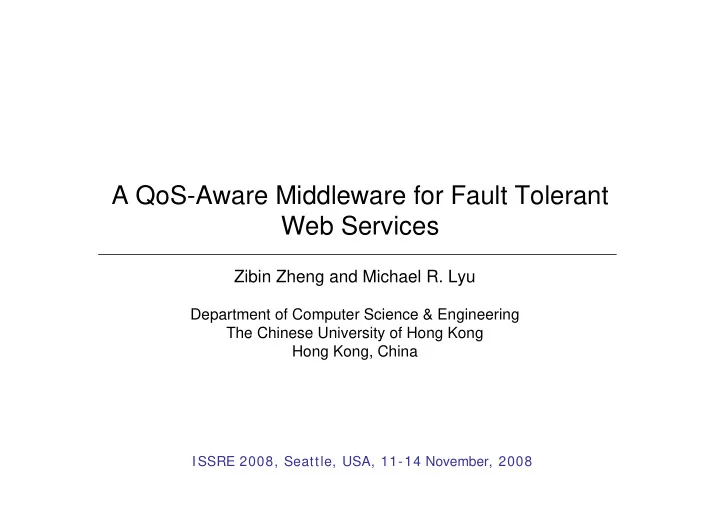

A QoS-Aware Middleware for Fault Tolerant Web Services Zibin Zheng and Michael R. Lyu Department of Computer Science & Engineering The Chinese University of Hong Kong Hong Kong, China ISSRE 2008, Seattle, USA, 11-14 November, 2008
Outlines 1. Introduction 2. A QoS-Aware Middleware 3. Fault Tolerance Strategies 4. Dynamic Strategy Selection Algorithms 5. Experiments 6. Conclusion and Future Work 2
1. Introduction • Web services are becoming popular. • Reliability of the service-oriented applications becomes difficult to be guaranteed. – Remote Web services may contain faults. – Remote Web services may become unavailable. – The Internet environment is unpredictable. x x W eb service 1 x Service Oriented Application W eb service 2 x W eb service n 3
1. Introduction • Traditional software reliability engineering – Fault Tolerance is a major approach for building highly reliable system. – Expensive. • Service reliability engineering – Abundant Web service candidates with identical/similar interface. – Less expensive & less time-consuming. • The Internet environment is highly dynamic – Network condition changes. – Software/hardware updates of the Web services. – Server workload changes. 4
1. Introduction For a service user: Lyric server 1 Lyric server 2 • Design time: Lyric server n 1. Which Web service is the best to choose? 2. What are the available fault tolerance strategies? 3. Which fault tolerance strategy is optimal? • Run time: 3. How to automatically determine the optimal fault tolerance strategy in a highly dynamic environment? 5
1. Introduction • A QoS-Aware Middleware for Fault Tolerant (FT) Web Services . – A user-collaborated QoS model • YouTube : sharing videos. • Wikipedia : sharing knowledge. • Sharing QoS information of target Web services. – Record QoS information of target Web services and exchange it with other service users – Determine the optimal fault tolerance strategy dynamically at runtime based on the QoS information 6
2. QoS-Aware Middleware • The need for overall QoS information (different locations and access time) of target Web services: – Service users • Web service selection and ranking. • Optimal fault tolerance strategy selection. – Service providers • Performance of their own Web service from different users. • Providing better services. • The overall QoS information is difficult to obtain – Time-consuming – Expensive 7
2. QoS-Aware Middleware 1. Coordinator address. 2. Replica list and QoS. 3. Optimal FT strategy. 4. Record QoS data. 5. Exchange QoS data. 6. Adjust for the optimal FT strategy. User-collaborated QoS-Aware Middleware 8
2. QoS-Aware Middleware • How to obtain functional identical Web services? – Machine learning techniques for automatic identification. – Service Communities: define a common interface so that the Web services provided by different organizations have the same functionality, although with different levels of non-functional quality of service (QoS). 9
2. QoS-Aware Middleware Coordinator User Replica list, Overall performance information Replica list, Overall performance information Individual Performance information Individual Performance information Replica list, Overall performance information Replica list, Overall performance information Individual Performance information Individual Performance information Replica list, Overall performance information Replica list, Overall performance information • Users share QoS information of the target Web services via the coordinator of the service community. • WS-DREAM: Web Service Distributed REliability Assessment Mechanism. • Middleware: users can close the data exchange functionality. • BitTorrent: users can close the upload. 10
3. Fault Tolerance Strategies f : failure rate t : access time • Retry • Recovery Block 11
3. Fault Tolerance Strategies • N-Version Programming (NVP) • Active 12
3. Fault Tolerance Strategies • Dynamic sequential strategy (Retry+RB) • Dynamic parallel strategy (NVP+Active) : u replicas in parallel, first v for voting. 13
4. Selection Algorithm User requirements: the largest RTT that the application can afford. the largest failure-rate that the application can tolerate. the largest resource consumption constraint. the mode can be set by the service users to be sequential , parallel , or auto . 14
4. Selection Algorithm The QoS model: 15
4. Selection Algorithm • The users may not be willing to store a lot of historical data. • Without historical data, it is difficult to make QoS predictions. Solution: Store the distribution • Dividing the time into k timeslots. • k+2 counters for k timeslots, fl and fn. • for calculating the probability of a certain RTT belongs to a certain category. 16
17 4. Selection Algorithm RTT Prediction:
4. Selection Algorithm RTT Prediction: min(Tv): Active strategy. max(Tv): NVP. middle(Tv, x): v parallel replicas and employs the first x response for voting. 18
4. Selection Algorithm • Sequential or parallel strategy determination: • Dynamic sequential strategy determination: Degradation factor • Dynamic parallel strategy determination: – RTT prediction algorithm – Combination numbers: 19
5. Experiments • The experimental system is implemented by JDK6.0, Eclipse3.3, Axis2.0, and Tomcat6.0. • Developed six Web services following an identical interface to simulate replicas in a same service community. • The six Web services and the community coordinator are deployed on seven PCs. – Pentium(R) 4 CPU 2.8 GHz, 1G RAM; – 100Mbits/sec Ethernet card; – Windows XP operating system. 20
5. Experiments • The new Dynamic approach gets the best overall performance. • Similar to the Active strategy. • With good RTT performance for User 1. 21
22 5. Experiments
5. Experiments 1. Traditional static fault tolerance strategies do not get good results consistently. 2. The proposed dynamic strategy obtains the best overall performance for all the six users in the experiments. 23
6. Conclusion and Future Work � Conclusion � An innovative QoS-aware middleware approach was proposed for reliable Web services � Dynamic fault tolerance replication strategies. � Dynamic replication strategy selection algorithm. � Encouraging experimental results were obtained. � Future work � Investigating more QoS properties. � Evaluation of stateful Web services. 24
A QoS-Aware Middleware for Fault Tolerant Web Services Zibin Zheng and Michael R. Lyu The Chinese University of Hong Kong Hong Kong, China Questions? ISSRE 2008, Seattle, USA, 11-14 November, 2008
Recommend
More recommend